Can you use acetone on wood? Acetones are terrible for wood, thus, it is not recommended to use them on wood. Acetone is the dominating chemical that is found in nail polish remover. Surely, you have plenty of times of using this chemical when maintaining your nails. Although there is no doubt that acetone can work well in removing some kind of stains, you must understand that applying acetone on woods can be extremely hazardous.
What is an Acetone?
Acetone is one of the most compelling and fastest evaporating solvents. It is also known for its characteristic of being very dry. Thus, it makes a perfect degreaser and cleaner and this is how most industries are utilizing it.
The woodworking industry is typically using acetone to varnish leftover parts or tear wooden furniture to have a clean coat application. Oftentimes, wood floor refinishers use acetone before the process of sanding to take off the upper layer of the finish before adding another finish.
You may have noticed your skin become dry once acetone touches it. This happens because of the volatility of the solvent and the rapid evaporation rate that absorbs the moisture in your skin. This kind of stripping can somehow be beneficial, however, the health risks can often overpower any benefits it gives. A lot of woodshops are going away from acetone because of the numerous safety risks it can impose.
Nevertheless, the rapid evaporation could also resemble increased flammability. A flame can incite an explosion if there is enough accumulation of vapor. Hence, it is always recommended to work with a functioning exhaust if you plan to use large-quantity acetone.
Its strength implies that acetone can scorch or take off finishes and paints. Thus, you must prevent using this solvent on woods.
How Does Acetone Affect the Wood?
Certain chemical products contain acetone and these products are purposely formulated to tear the wood and get rid of any occurring stains on the wood floor. The acetone in these formulations acts aggressively as it instantly starts to penetrate the paint or stain on the floor.
The question now is – can you use acetone on wood? It is never ideal to use acetone on the hardwood. However, you may want to apply it to concealed areas – such as the part that is covered by the rug. Simply get a cotton swab and wet it with a little quantity of acetone. After then, soak a cloth in clean water and use it to wipe the acetone away.
Acetone-based type of nail polish removers have the same impact on wood as paint stripper or full-strength acetone. Your wood floor can suffer from discoloration and damage even if only a little amount of acetone is spilled into it.
How to Address Cases of Accidentally Spilling Acetone on Wood?
Some unpleasant things can really happen, no matter how careful you are. If you accidentally spill the acetone on your wood, you should be quick with your actions. Immediately dry it up with a clean lint-free cloth or paper towel. The lesser acetone remains on the finish, the lesser is the adverse effect to the wood.
When you accidentally spill acetone to your wood, the impairment is nearly confined to the finish. Repairing acetone-damaged woods are commonly limited to the finish. However, if you spilled the acetone on bare wood, you will notice that there are no significant injuries to the wood. This is because of the quick evaporation rate. However, it can cause the grain to slightly lift.
So, what should you do if acetone touches the wood?
Drizzle the affected spot with a bit of coating of aerosol lacquer. Once the lacquer dries up, use steel wool to gently sand it and then drizzle again. If there is still a bit of depression noticed, consider drizzling it twice or thrice.
What is Acetone Used For?
Acetone is an ideal solvent for numerous plastics as well as certain kinds of synthetic fibers. It is commonly used to clean tools, thin polyester resin, and dissolve superglue and epoxies before they get the chance to harden. It is used as one of the elusive elements of varnishes and paints.
Since acetone is mixable with water, you can also use it to remove residual water that attaches to spray equipment when changing to a solvent-based from a water-based product. It can be used to quicken the speed of cleaning oil-graze and oil-stain brushes before cleansing it with water and soap.
Conclusion
Can you use acetone on wood? Surely, acetone is formulated with a certain purpose. However, when it comes to wood application, you wouldn’t want to use this solvent as it can potentially damage your furniture or floor. It may look like a simple liquid, but it has enough strength to weaken finishes and paints.
In case of a spill on woods, no matter how little the amount of the acetone is, you must hurriedly act on the situation to prevent the solvent from thoroughly penetrating your wood.


Leave a Reply